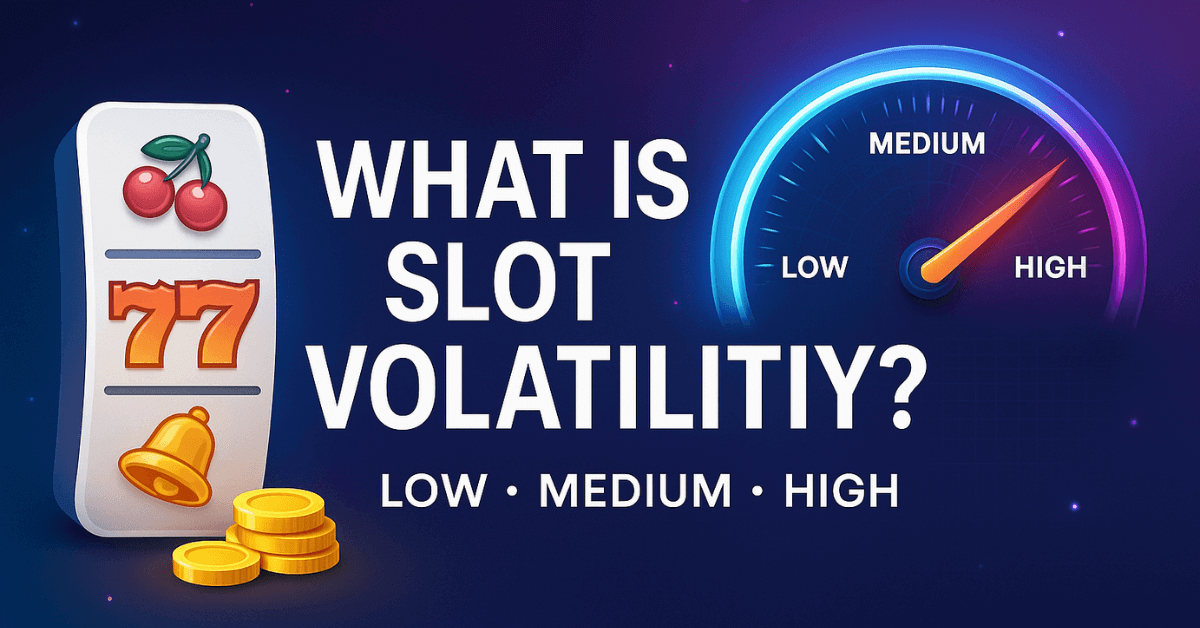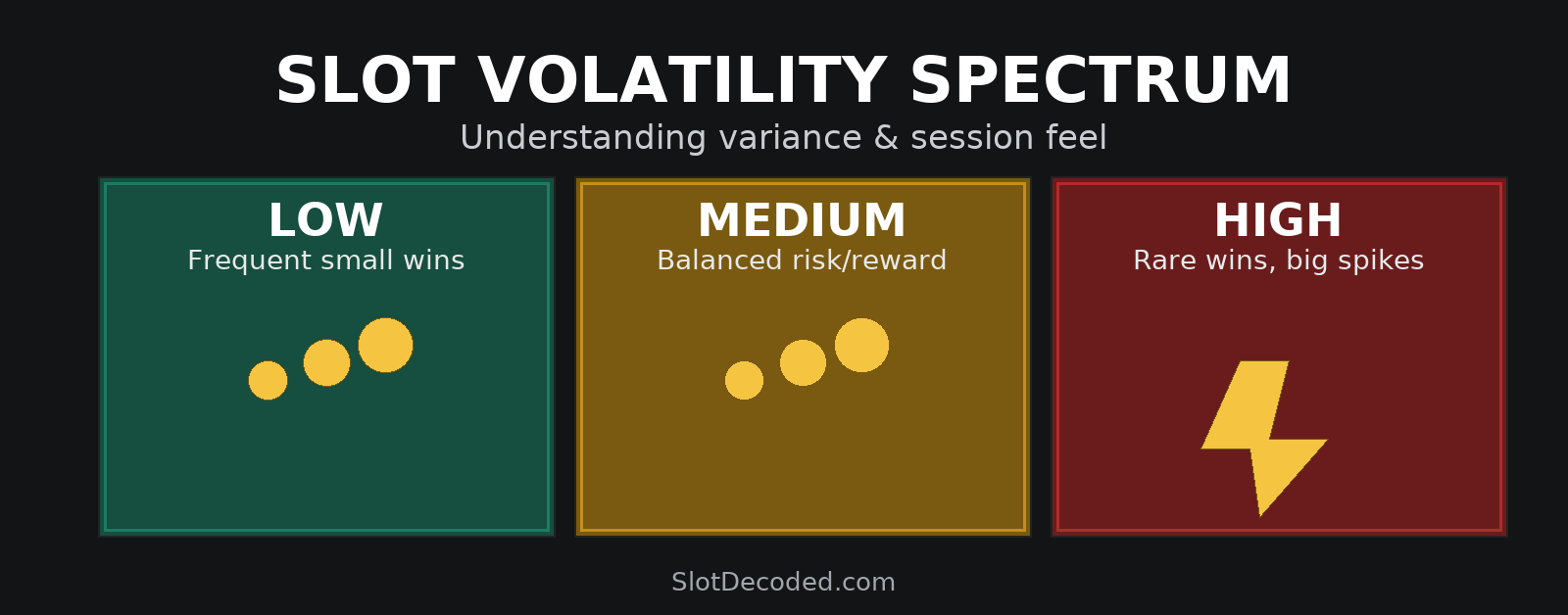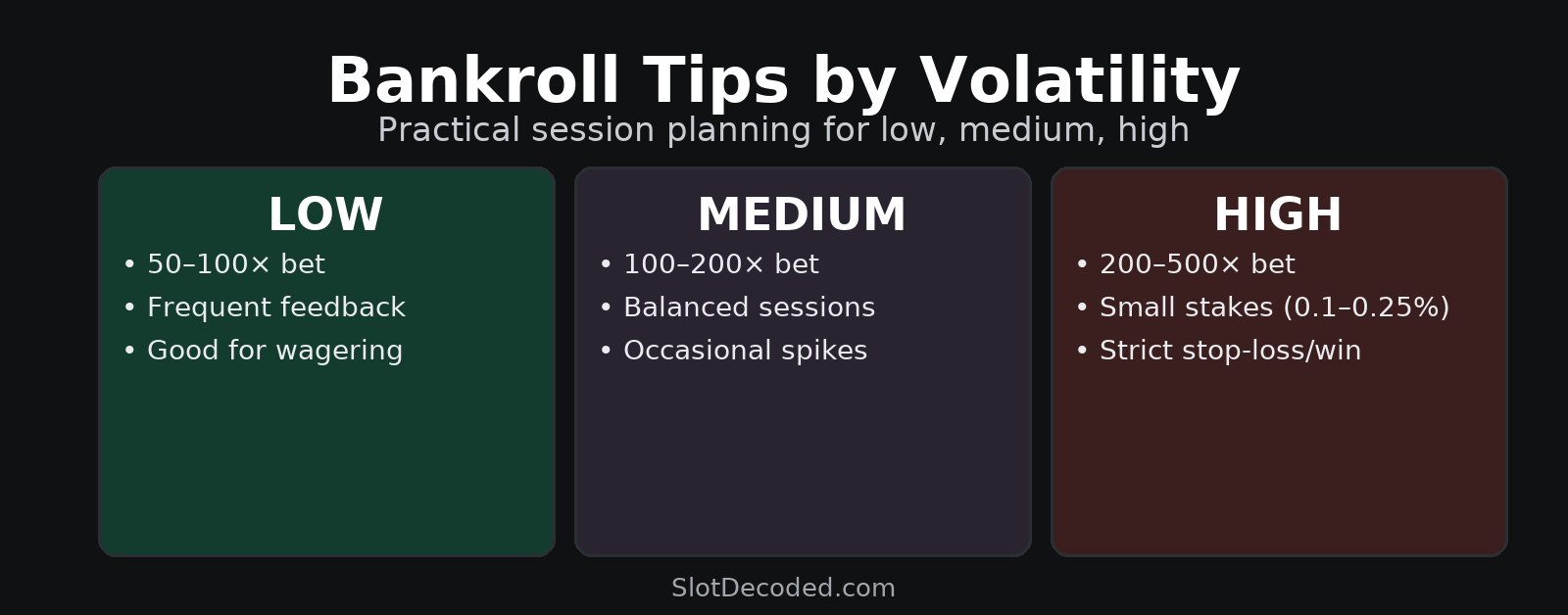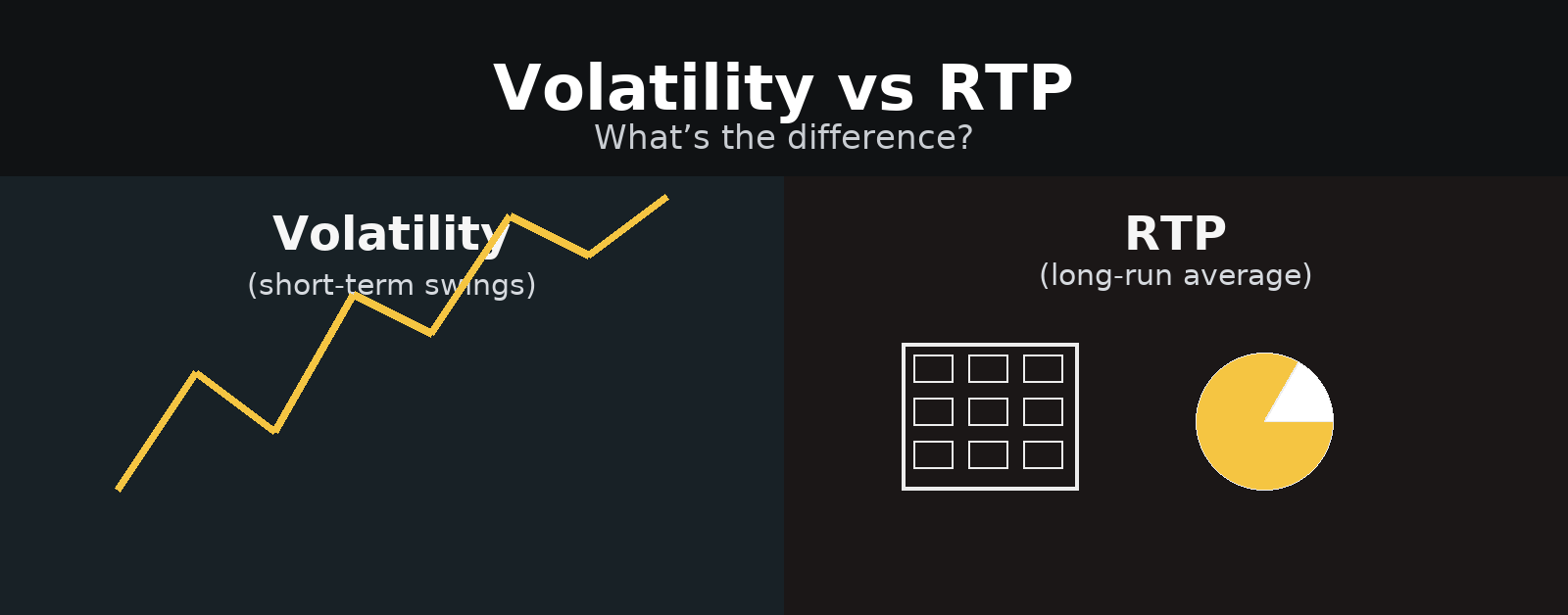
Introduction
Ever wondered why some slot games pay small amounts often, while others seem dry for ages before a big win? The answer lies in slot volatility. Also known as variance, this concept shapes how a slot feels, how it pays, and how you should manage your bankroll. Understanding volatility helps you compare games beyond themes and Symbols (like Wilds, Scatters, and Bonus Symbols), set realistic expectations, and pick titles that match your goals—whether you’re chasing a Max Win highlight or just looking for steady entertainment.
Quick take: slot volatility describes the distribution of outcomes (hit frequency vs. payout size); Return to Player (RTP) describes the long-run average. You’ll feel volatility every session. You’ll feel RTP over very long play. (If you’ve ever asked “Are Online Slots Fair?”, this is part of the answer—see also RNG, Licensing Authorities like MGA and UKGC, and audits.)
What Is Slot Volatility?
Slot volatility indicates the risk profile of a slot in terms of how frequently it pays and how large wins tend to be. In practical, plain-English terms:
In practical, plain-English terms:
- Low volatility: lots of small wins; balance moves slowly.
- High volatility: fewer wins, bigger potential; balance can swing fast.
- Medium volatility: a middle path with a mix of small hits and occasional spikes.
Two nuances most players miss:
- Labels aren’t standardized. One studio’s “High” can feel like another’s “Medium-High.” Treat the label as a guide, not a guarantee.
- Volatility and RTP are different levers. RTP (e.g., 96%) is the average over huge samples. Volatility is how bumpy the ride is on the way to that average. A 96% game can be calm or wild depending on its volatility curve.

How volatility shapes your session
- Hit Rate (the chance any given spin returns something) generally trends higher on low-volatility games and lower on high-volatility games. Note: “felt” hit rate can differ from the math due to near-misses and Player Psychology effects.
- Feature design drives variance: Megaways, Cluster Pays, Expanding Reels, sticky multipliers, and jackpot side bets typically increase slot volatility.
- Max Win & top symbol distribution: the more top-heavy a paytable (huge top prizes, low mids), the spikier the game.
At-a-glance spectrum
| Profile | Session feel | Typical outcomes | Who it suits |
|---|---|---|---|
| Low | Frequent feedback | Many line wins; modest features | Smaller bankrolls, long casual sessions |
| Medium | Balanced | Regular teases + decent bonuses | Most recreational players |
| High | Long droughts, big spikes | Rare features, heavy multipliers | Thrill-seekers with patience & discipline |
Understanding volatility helps you set realistic expectations and choose the right games for your session and bankroll.
Low Slot Volatility: Safe and Steady
Frequent wins, smaller payouts. Ideal if you value playtime and consistent feedback over headline moments.
Pros
- Smoother balance line; fewer long losing streaks
- Great for learning slot mechanics and understanding Ways to Win vs. Paylines
- Useful for bonus wagering (steady contribution)
Cons
- Limited top-end potential; “big wins” are usually capped by design
- Can feel repetitive if you crave feature drama
How they’re built
- Base-game centric with frequent pairs/triples and small line/cluster pays
- Light multipliers or low-ceiling features
- Conservative max-win targets (e.g., ~500×–2,000×)
Bankroll & bet sizing tips
- Typical session bank: 50–100× your average bet
- Because swings are gentler, you may bet slightly higher per spin (still keep it responsible)
- Add Responsible Gambling Tools: reality checks every 20–30 minutes to prevent “autopilot” play
Example mechanics that often skew lower
- Fixed Paylines with mild symbol ladders
- Cluster Pays with capped multipliers
- Simple expanding/wild features without retriggers
Games often referenced on the low side: iconic “evergreen” titles designed for steady play.
High Slot Volatility: High Risk, High Reward
Sparser hits, bigger ceilings. These are the titles that fuel stream highlight reels and “dream” screenshots.
Pros
- Massive potential (5,000×, 10,000×, sometimes higher)
- Big adrenaline via multipliers, expanding wilds, and feature ladders
Cons
- Long dry spells are normal—bankroll can decay quickly
- Emotionally taxing; easy to Chase Losses if you’re not careful (avoid Chasing Losses)
How they’re built
- Top-heavy paytables: big gap between average hit and top symbols
- High-impact features: growing multipliers, rare retriggers, high-variance bonus structures
- Jackpots (including progressives) push variance further; a chunk of RTP sits in rare events
Bankroll & bet sizing tips
- Treat high-vol games like “lottery-with-entertainment”:
- Session bank: 200–500× your average bet (rule of thumb, not a promise)
- Stake per spin: 0.1–0.25% of bankroll to survive dry patches
- Stop-loss and stop-win pre-set; if a feature lands, consider banking a portion
- If the game offers Feature Buys, they increase variance further—plan a fixed number (e.g., 3–5) rather than “one more” loops
Example mechanics that often skew higher
- Megaways with huge reel expansion and avalanche chains
- Expanding Reels/ways escalating to five-figure ways
- Volatile Bonus Symbols that unlock multiplier ladders or limited “super” bonus modes
Provider flavors to mention for internal linking
- Pragmatic Play: many high-volatility fan favorites with multiplier features
- NoLimit City: known for extreme variance and edgy designs
- Shady Lady: a new-provider spotlight on math philosophy and Successful Slot Game design
Game Examples: Dead or Alive 2 (NetEnt), Gates of Olympus (Pragmatic Play), Wanted Dead or a Wild (Hacksaw), San Quentin (Nolimit City), Money Train 4 (Relax).
Medium Slot Volatility: The Balanced Option
The middle road: enough action to keep you engaged, with a realistic shot at a memorable bonus.
Why players pick medium
- Steady base-game trickle + respectable features
- Good for 30–90 minute sessions where you want a shot at something meaningful without brutal droughts
Bankroll & bet sizing tips
- Session bank: 100–200× your average bet
- Keep stakes steady; only “nudge” higher if the game allows a clear-value toggle (e.g., ante bet that genuinely increases feature rate)
Mechanics that suit medium
- Hybrid Ways to Win/Paylines with mid-tier multipliers
- Wilds expand but with controlled caps; Scatters trigger bonuses at reasonable frequency
- Max wins often in the 2,000×–5,000× band
Examples: Book of Dead (Play’n GO), Gonzo’s Quest (NetEnt)
How to Check a Slot Volatility
Studios often label volatility in the info/paytable, but here’s how to sanity-check it yourself:
- Read the paytable shape
- Huge gaps between mid symbols and top symbol ⇒ higher slot volatility.
- Very high Max Win with modest line pays ⇒ expect spikiness.
- Inspect feature design
- Multiplying wilds, escalating multipliers, rare Scatter Symbols combos, or hard-to-trigger “super bonuses” usually imply high variance.
- Games with frequent micro-features (mini respins, low-cap modifiers) lean lower.
- Test in demo (when available)
- Run 100–200 spins to feel Hit Rate, bonus frequency, and base-game sustain.
- Track average return per 100 spins to sense short-term variance (purely indicative).
- Consider jackpots and side bets
- Jackpots and side pots reallocate RTP towards rare events, increasing volatility.
- Progressive networks (player-funded) can be fun but swingy.
- Check fairness & versions
- RNG is what makes spins unpredictable.
- Verify license (MGA, UKGC, other Licensing Authorities) and note that some titles have multiple RTP profiles across Online Casinos. Lower RTP reduces long-term value but doesn’t necessarily change the volatility pattern you feel per session.
- Hit Rate vs. RTP vs. House Edge
- Hit Rate: how often you get any win (affects “feel”).
- RTP: long-term payback (e.g., 96% ⇒ House Edge ~4%).
- House Edge and volatility are different: one is the long-run take; the other is the path (calm vs. spiky) to that take.

Tips for Playing Based on Slot Volatility
These are practical, math-aware Tips you can actually use.
For low volatility
- Goal: long playtime, steady engagement.
- Plan: session bank 50–100× bet; accept many small outcomes.
- Strategy: try modest stake increases after bonus rounds only if your balance can absorb it; avoid speed modes to keep control.
- Good tie-ins: wagering balance, Casino Bonuses that require turnover, “fun budget” mindset.
For medium volatility
- Goal: a mix of playtime and the chance at a memorable bonus.
- Plan: 100–200× bet bankroll; keep stakes steady; use reality checks.
- Strategy: if a game has an ante that provenly lifts feature odds for a small cost, it can be worth it; otherwise keep it off.
For high volatility
- Goal: take intelligent shots at big outcomes while protecting your mood and bankroll.
- Plan: 200–500× bet bankroll; keep each spin to 0.1–0.25% of session funds.
- Strategy: define stop-loss/stop-win before you start; if you land a top-tier feature, consider banking profits and Take a Break.
- Mindset: avoid Chase Losses/Chasing Losses—variance clusters happen; they aren’t “due” to reverse. Use Self-Exclusion and Responsible Gambling Tools if you feel pressure to continue.
Bankroll sanity table (rule-of-thumb)
- Want ~300 spins on low-vol? Bank ≈ 60–120× bet.
- Want ~300 spins on medium? Bank ≈ 90–180× bet.
- Want ~300 spins on high-vol? Bank ≈ 150–300× bet (and still no guarantees).
Note on psychology. High-vol games leverage suspense, near-misses, and escalating Slot Features. This can feel addictive for some—engineered anticipation is part of modern design. Set session timers and keep play fun.

Volatility vs RTP: What’s the Difference?
You’ll often hear both terms together, so here’s the clean separation:
- RTP (Return to Player): the theoretical long-run % a game pays back (e.g., 96%). Over millions of spins, the average return tends toward this number.
- Volatility: the shape of outcomes. Two 96% games can feel totally different if one is low-variance (steady trickle) and the other is high-variance (dry, then boom).
Why this distinction matters
- In short sessions, volatility dominates experience. RTP barely has time to express itself.
- In long, repeated sessions, lower RTP versions take a toll even if slot volatility is unchanged. That’s why picking a Legal, licensed site with higher-RTP configurations (where possible) is smart.
Related concepts you can link internally
- House Edge (100% − RTP)
- Hit Rate (felt frequency of wins)
- How Slots Work (RNG, seed, unpredictability)
- Strategies (bankroll planning, stake sizing, when not to play)
- Classic vs. Modern Slots (how math, graphics, and UX evolved)
RTP, Slot volatility & features
- Jackpots: push variance up; may lower base-game sustain.
- Megaways / Expanding Reels: raise both excitement and variance.
- Cluster Pays: variance depends on cluster size, multipliers, and removal mechanics.
- Crash Games (for a contrast article): different math model entirely—continuous multipliers + cash-out timing—often very swingy despite visible curves.
Conclusion
Volatility is your shorthand for how a slot behaves in the short run. Match it to your bankroll, temperament, and time. If you want playtime and consistent feedback, start with low volatility. If you’re comfortable with droughts in exchange for a shot at something special, consider high slot volatility—but set firm limits and avoid Chasing Losses. Most players will land naturally on medium volatility for a healthy blend of action and possibility.
Remember, RTP is the long-term average; volatility is the ride. Verify fairness (licensed Online Casinos, reputable Licensing Authorities like MGA and UKGC, audited RNG), play versions with fair RTP where possible, and keep the experience fun with Responsible Gambling habits. If play ever stops being enjoyable, Take a Break—tools like Self-Exclusion and deposit limits exist to help.
Want More Guides Like This?
Explore our other educational articles on RTP and Slot Math, Responsible Gambling, and How Online Slots Work to level up your slot knowledge.
FAQ: Slot Volatility (Plain-English Answers)
What does “slot volatility” mean in simple terms?
It’s the game’s risk profile—how often you get wins and how big they tend to be. Low volatility = frequent small wins; high volatility = rarer wins but bigger spikes; medium sits between.
Is slot volatility the same as RTP?
No. Volatility is the distribution of outcomes (calm vs. spiky). RTP / Return to Player is the long-run average (e.g., 96%). Two games can both be 96% RTP yet feel totally different because their volatility curves differ.
Does higher volatility mean lower RTP?
Not necessarily. They’re separate levers. A game can be high-volatility at 96% RTP or low-volatility at 96% RTP. RTP affects long-term value; volatility shapes short-term swings and session feel (and perceived House Edge over short samples).
How can I tell a slot volatility if it isn’t listed?
Scan the paytable/top symbol values (very top-heavy usually = higher variance), look at feature design (hard-to-trigger bonuses, big multipliers), test the demo to feel Hit Rate, and read trusted reviews. Jackpots and rare Bonus Symbols combinations typically raise variance.
Which volatility should I pick for my bankroll and time?
Low: smaller budget, long casual sessions, steady feedback.
Medium: balanced sessions (30–90 mins) with shots at a decent bonus.
High: bigger bankroll, patience for droughts, aiming for headline wins (set strict limits).
What’s Hit Rate and how does it relate to volatility?
Hit Rate is the chance any spin returns something. Low-vol games often have higher hit rates (lots of small line/cluster wins). High-vol games usually have lower hit rates but bigger peaks when features land.
Do features like Megaways, Cluster Pays, or Expanding Reels change volatility?
Often, yes. Large way counts, growing reels, avalanche chains, and multiplier ladders tend to increase variance. By contrast, frequent mini-features that award small boosts can lower the perceived volatility.
Are jackpot slots always high volatility?
Progressive or large fixed Jackpots shift a chunk of RTP into rare events, so they raise variance. You may see long dry spells while “buying a ticket” toward a rare outcome.
How do House Edge and volatility interact?
House Edge (100% − RTP) is the casino’s long-run margin; volatility is the bumpy path to that margin. A 96% game (~4% edge) can feel either calm or wild depending on variance. Over short sessions, volatility dominates your experience.